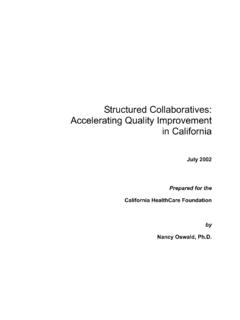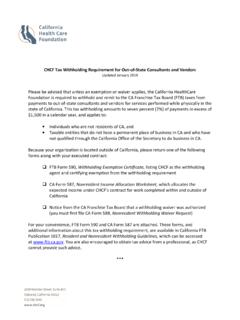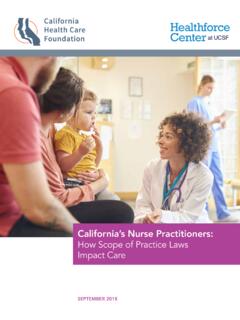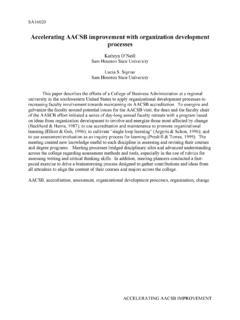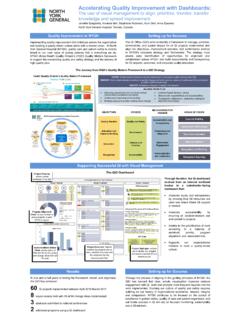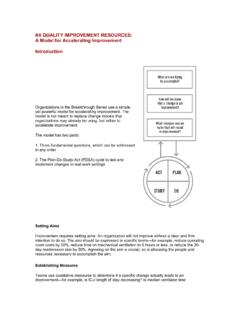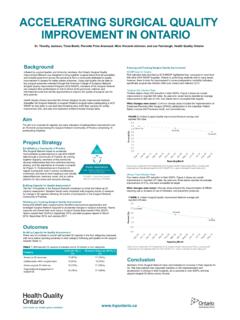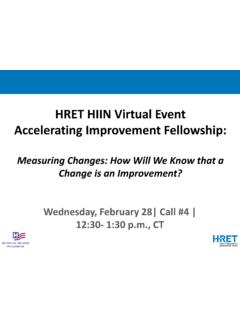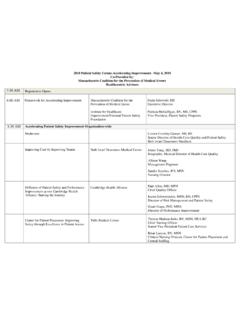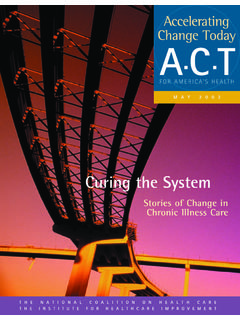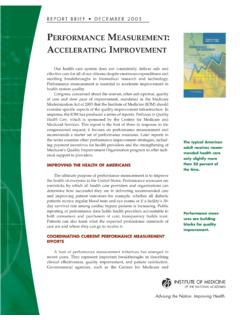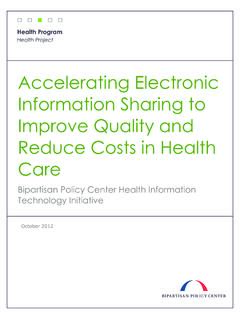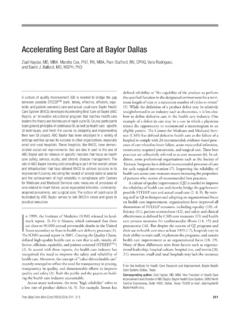Transcription of Lessons Learned from Accelerating Quality Improvement ...
1 HARVEST OF Lessons Learned from Accelerating Quality Improvement through collaboration for The California Health Care Foundation December 2010 Prepared by Jane Taylor, and Susanne Salem-Schatz, 2 Table of Contents I. pg 3 II. pg 3 III. Summary of Findings .. pg 4 IV. Recommendations .. pg 6 V. pg 9 Appendix A. List of pg 22 Appendix B. AQIC Harvest Interview pg 23 3 I. INTRODUCTION PURPOSE The purpose of this undertaking is to provide a qualitative harvest of Lessons Learned from the Accelerating Quality Improvement through collaboration (AQIC) based on the actual experiences, insights, and learning of program participants. In the context of current and ongoing national initiatives to implement electronic health records, reorganize features of health care delivery and improve Quality , understand facilitators and barriers to implementing systems and using data for Improvement will inform the work of those supporting these changes.
2 Specifically, this will help identify what Lessons have application for the Implementation of HITECH, namely, the Department of Health and Human Services rules to help improve Americans health, increase safety and reduce health care costs through expanded use of electronic health records (EHRs). Accelerating Quality Improvement through collaboration The goal of AQIC was to spur the adoption of Quality Improvement methods and use of electronic data by California s safety net clinics to more rapidly improve diabetes (and ultimately other chronic disease) care for low-income patients. The initial structure for this was support for two statewide associations of safety net clinics to provide Quality Improvement processes across their constituencies. Focusing on diabetes measures, thirteen regional consortia worked with member clinics to accelerate the adoption of electronic disease registries, and implement the use of standardized clinical measures and regular reporting of performance, using common definitions and methodologies for data collection and aggregation.
3 Financial incentives for consortia tied to measures reporting led to increased success on this dimension. Informing support for HITECH As part of the American Recovery and Reinvestment Act of 2009 the Health Information Technology for Economic and Clinical Health (HITECH) Act authorizes authorized incentive payments through Medicare and Medicaid to clinicians and hospitals when 4 they use EHRs privately and securely to achieve specified improvements in care delivery. Among the programs created by the Department of Health and Human Services to fulfill this goal is the establishment of Regional Extension Centers (RECs), to support providers in adopting and becoming meaningful users of health information technology (HIT). In California, a network of Local Extension Centers (LECs) has been established to coordinate Regional Extension Center services in local communities.
4 LECs may be local clinic consortia, regional medical societies, health plans, or any other group that have the ability to assist providers in a community. Clarifying the Lessons Learned by those who supported AQIC activities may offer guidance to the California REC and LECs, as well as Consortia and other organizations engaged in supporting Quality Improvement and the adoption of electronic records for meaningful use. Organization of this report Following a description of methods, we begin with a summary of findings organized by the themes that emerged through analysis of interviews with AQIC participants. These include Leadership Engagement; Customization and Standardization; Sequence and Strategy; Time and Resources; Relationships and Teamwork; and Moving Toward Meaningful Use.
5 We follow this with a set of recommendations for supporting organizations working to promote meaningful use of electronic data in current and future initiatives. Recommendations are grounded in the context of our work both as evaluators and active participants in the work of Quality Improvement . Finally, we include a detailed presentation of our findings from interviews with AQIC participants. II. METHODS We conducted twelve telephone interviews with seventeen AQIC participants during June and July, 2010. Participants were consortia leaders, Quality Improvement professionals, clinic staff including one chief medical officer, and one external consultant (see List of Participants in Appendix A). We used a semi-structured interview schedule (see Interview Schedule in Appendix B).
6 All but one interview was audio recorded and 5 notes were taken during the interviews. The recordings and field notes were reviewed and coded independently by both evaluators for themes and checked for inter-rater reliability. After initial review and coding, findings were organized into a set of themes, which we use below to describe our findings. III. SUMMARY OF FINDINGS Leadership Engagement Meaningful Use will require strong clinic management and engaged leaders. The critical importance of engaging leaders in the work was unanimously noted by interviewed participants. Leaders promoted successful implementation by creating shared vision and common goals, establishing expectations and providing time and resources for the work. The role of the consortia can be critical for developing these, as well as providing a structure to support the work.
7 Consortia served clinic leaders best when they created opportunities for them to learn from each other in face to face settings where data was shared transparently; where problems and learning were openly discussed. Customization and Standardization Clinics are different and at different stages of IT and QI development. Consortia addressed this by offering varying combinations of group learning and individual consultation. Consortia also bring to the table different resources and skill sets, and were required to balance the needs of clinics with their own internal resources. Implementation challenges were greater when there was a disconnect between consortia capabilities and the health information and Quality Improvement needs of the clinics. Consortia were better able to support implementation when they were able to standardize IT vendors used by their clinics.
8 Consortia were more successful when they could accurately assess what a clinic needed, as were those who could take experiences Learned from one clinic and apply it to another. Successful consortia took advantage of clinics who pioneered the way with IT and used them to help clinics with less experience. Sequence and Strategy 6 There was good agreement among those interviewed about the high level sequence of steps, including goals and assessing current processes, assessing capabilities, workflow redesign with attention to operations Improvement , data collection and validation, and data review and sharing for meaningful use. The experience of implementing registry was considered to be an important building block for moving on to EHR. Beyond sequence, consortia encouraged a core set of strategies including convening multidisciplinary teams at the clinics, using Quality Improvement methods to redesign processes and do small tests of change, creating opportunities for shared learning between clinics, and targeted training, using a mix of face to face learning sessions and on-site consultation.
9 Time and resources Nearly every participant observed that clinics underestimated the time and effort it takes to implement and learn to use registries and EHRs. In addition to time for data collection, validation and report generation, teams need time and space to reflect on the meaning of the data. Consortia also faced time and resource constraints, and used a variety of strategies to leverage learnings from clinics to help others. Relationships and Teamwork The value of shared learning cannot be underestimated. At every level, relationships cemented during face to face sessions echoed with positive interactions and collaborations. Consortia provided learning and sharing opportunities for clinic leadership that were highly valued, and they in turn, valued the sharing and learning that happened when consortia leaders were brought together.
10 At the level of individual clinics, teams who worked together were more successful in implementing electronic systems and using data for Improvement . Consortia who had staff capable of supporting work flow Improvement , IT and QI were best poised to facilitate change in their clinics. Moving toward meaningful use Consortia with the trifecta of strength in leadership, QI and IT were best able to support their clinics in approaching the meaningful use of data, though many noted the multiple steps that needed to occur before this was possible. There are many steps that 7 precede the ability to use data for Improvement , and these take time. Additionally, the complexity of data measurement, validation and reporting is vastly underestimated and clinic staff, in general, have a superficial understanding of measures and pitfalls of data definitions.
